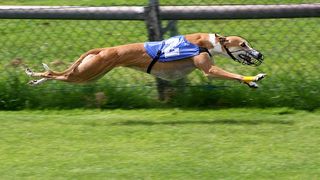Race and Ethnicity
Could Dogs Be the Fastest Land Animals in the World?
Except in a sprint race, greyhounds are faster than cheetahs.
Posted August 18, 2009 Reviewed by Jessica Schrader

To determine the fastest animal in the world, one has to consider the nature of the race that you are going to ask them to run. If you were running an air race with level flight, your champion would be the swift, which can fly at 106 miles per hour (171 km per hour). Peregrine falcons are slower but can reach speeds up to 69 mph (112 km/h) in direct pursuit of prey, however, when he is diving he can reach the incredible speed of 242 mph (389 km/h), which would easily allow him to catch a fleeing swift. For a water race, the sailfish blows the competition away. Its streamlined body can travel up to 68 miles per hour (109 km per hour) and the swordfish can do around 60 mph (97 km per hour).
Once we get speed on land, however, the most important consideration is going to be the distance over which the race is run. Much like in human track competitions, the shorter, sprint races, will produce the fastest times. The longer races can't sustain the speed you get in the shorter runs. If we just take the peak speed that an animal can reach then, as most people already know, the fastest land animal is the cheetah which can reach 70 mph (113 km per hour). Although the cheetah is an astonishingly fast runner, he can only maintain that incredible velocity for about 200 to 300 yards (274 meters) or less than two-tenths of a mile. These high speeds only allow the cat to overtake its prey within short distances, so cheetahs must still rely on stealth, sneaking, and the element of surprise to get close enough to the gazelle before giving chase.
The fastest of horses is also a sprinter. It is the quarterhorse, which gets its name from the fact that it was typically run in quarter-mile-long (0.4 km) races. It can reach 47.5 mph (76 kph) over that distance, but it has pretty much burned out by the half-mile (0.8 km) marker. Horses are considerably slower than this peak value over a longer distance. When the thoroughbred racehorse, Secretariat set the Kentucky Derby speed record in 1973 he ran it at 38 mph (61 kph) over a distance 1.5 miles (2.4 km).
However, humans have changed dogs so that some dogs can run much faster than most other animals. The really fast dogs are greyhounds, whippets, Salukis, and Afghan hounds, which are called sighthounds since their job is to spot their quarry by sight and run it down. The characteristic shape of these dogs involves a huge chest to accommodate large lungs to gulp oxygen and their oversized heart, plus a narrow waist that allows them to bend their body so that every stride carries them more than a body length.
The fastest of these dogs is the greyhound. He is specially designed for sustained high-speed running. While he is going at full tilt, the dog's heart rate can rise to 300-360 beats/minute. This means that the greyhound heart can contract and refill with blood five times per second during a race, allowing oxygen to be transported at a phenomenal rate to supply the needs of the muscles. His ability to reach top speed quickly is amazing. At maximum acceleration, a greyhound can reach a speed of 45 mph (72km/h) within its first six strides from a standing start. No other land animal (except the cheetah) has that degree of acceleration.
To give you an idea of how fast a sprinter the greyhound is, compare his performance to that of an elite human runner. When Usain Bolt set his 100-meter world record, he was running at a speed of 22.9 mph (36.9 kph) and covered that distance in 9.58 seconds. A greyhound would complete that same race in 5.33 seconds.
However, the greyhound is also a distance runner. He can settle into a speed in excess of 35 miles per hour and can run at that rate for distances as great as seven miles (11 kilometres). This means that while the cheetah can win the short sprint race, in any long race the greyhound will leave that big cat way behind, panting in the dust.
Some dogs do even better in super-marathon races, however. For this, we need a different type of dog. Consider the sled dogs, like those that participate in the Iditarod sled race. These dogs are primarily Siberian Huskies or Alaskan Huskies (an unregistered breed that has been designed for speed and endurance). The Iditarod race goes from just outside of Anchorage Alaska to Nome, and it covers a distance of 1,161 miles (1,868 km). The dog teams in this race run up to 125 miles per day, often racing for up to six hours at a time, for nine to 14 days, pulling a sled weighing over 100 kg. Furthermore, they run at full-tilt in extremes of climate, where the wind chill value can be -100 °F (-73.3 °C). The record for the Iditarod race is currently eight days and 22 hours. A sled dog's typical racing pace averages between 10 to 12 miles per hour (16 to 19km/h), which means that every six-hour running period, he covers about 70 miles (112 km). These dogs keep this up for an average of 11 days! It is hard to imagine any other animal on land that could keep up that kind of pace.
Stanley Coren is the author of many books, including The Modern Dog, Why Do Dogs Have Wet Noses? The Pawprints of History, How Dogs Think, and more.
Copyright SC Psychological Enterprises Ltd. May not be reprinted or reposted without permission.


